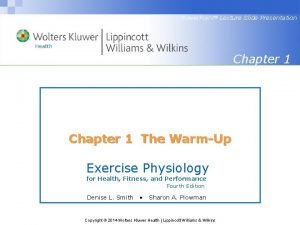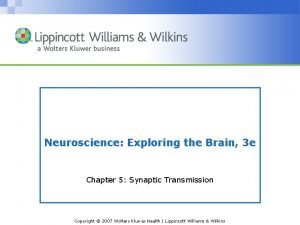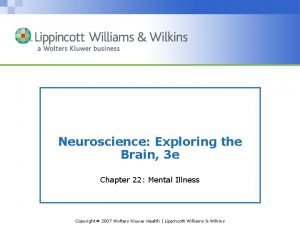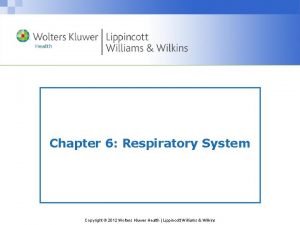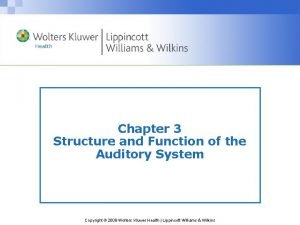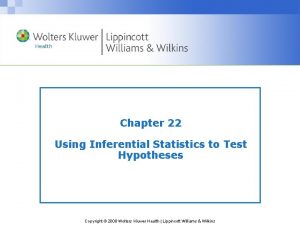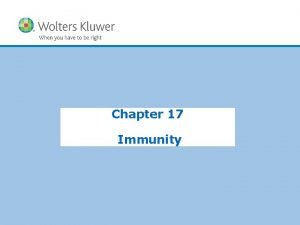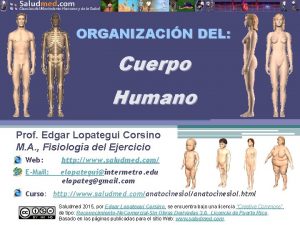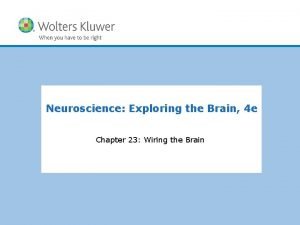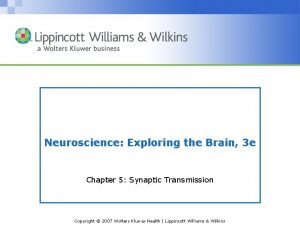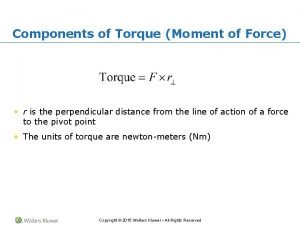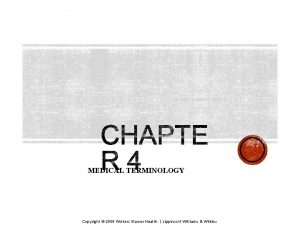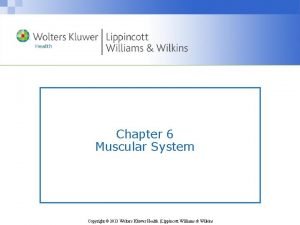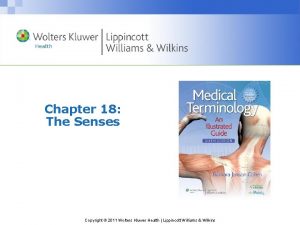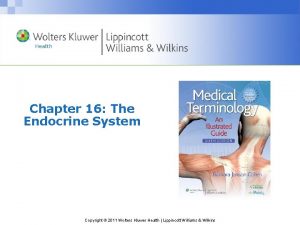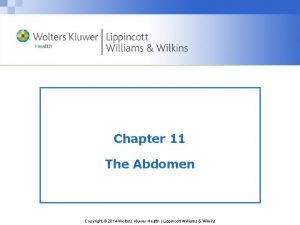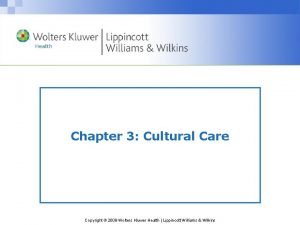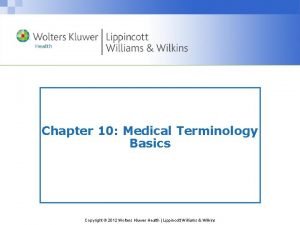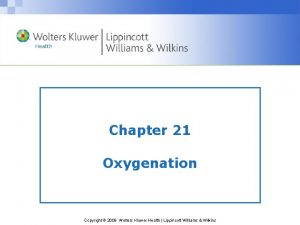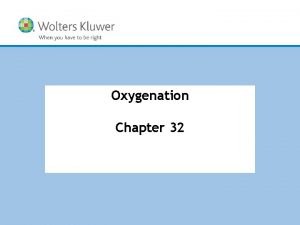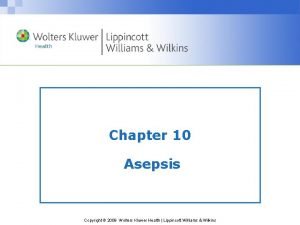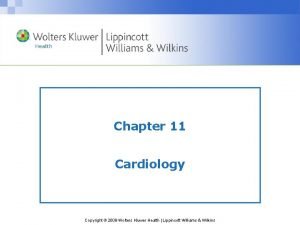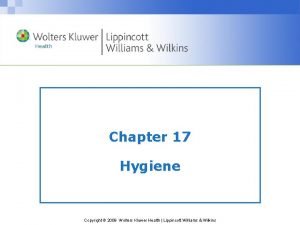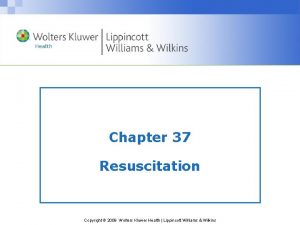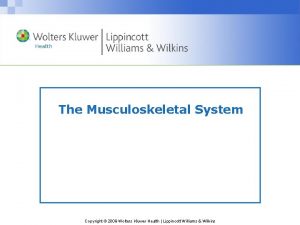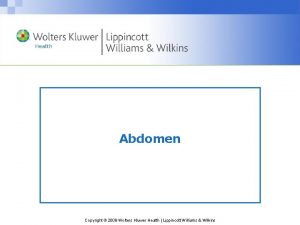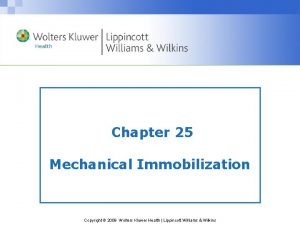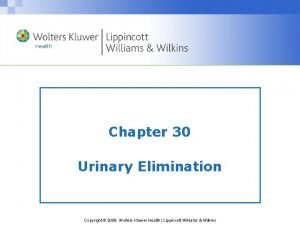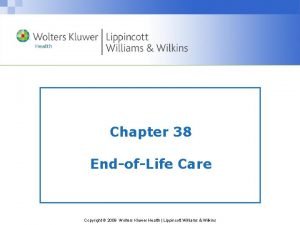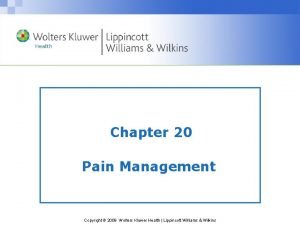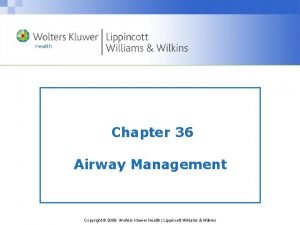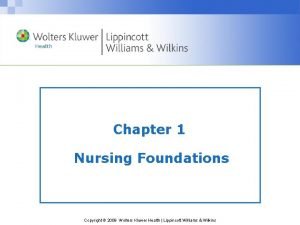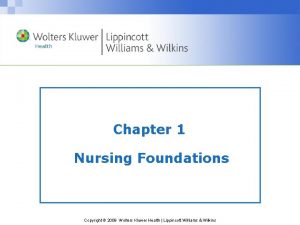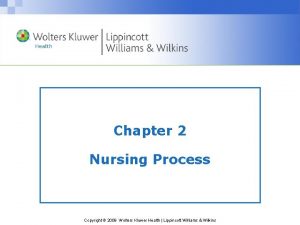Chapter 21 Oxygenation Copyright 2009 Wolters Kluwer Health




























- Slides: 28

Chapter 21 Oxygenation Copyright © 2009 Wolters Kluwer Health | Lippincott Williams & Wilkins

Oxygenation • Oxygen: measures approximately 21% in the Earth’s atmosphere • Each cell of the human body uses oxygen to metabolize nutrients and produce energy • Without oxygen, cell death occurs rapidly Copyright © 2009 Wolters Kluwer Health | Lippincott Williams & Wilkins

Question • Is the following statement true or false? Expiration creates more chest space, causing the pressure within the lungs to fall below that in the atmosphere. Copyright © 2009 Wolters Kluwer Health | Lippincott Williams & Wilkins

Answer False. Inhalation creates more chest space, causing the pressure within the lungs to fall below that in the atmosphere. Copyright © 2009 Wolters Kluwer Health | Lippincott Williams & Wilkins

Anatomy and Physiology of Breathing • Inspiration and expiration • Ventilation: movement of air in and out of lungs; facilitates respiration • Respiration: exchange of oxygen and carbon dioxide Copyright © 2009 Wolters Kluwer Health | Lippincott Williams & Wilkins

Anatomy and Physiology of Breathing (cont’d) • External and internal respiration – External respiration takes place at most distal point in airway: between the alveolar-capillary membranes – Internal respiration occurs at the cellular level between hemoglobin and body cells Copyright © 2009 Wolters Kluwer Health | Lippincott Williams & Wilkins

Assessing Oxygenation • Physical assessment – Monitoring the client’s respiratory rate – Observing breathing pattern and effort – Checking chest symmetry – Auscultating lung sounds Copyright © 2009 Wolters Kluwer Health | Lippincott Williams & Wilkins

Assessing Oxygenation (cont’d) • Arterial blood gases measure: – Partial pressure of oxygen dissolved in plasma – Percentage of hemoglobin saturated with oxygen – The p. H of blood Copyright © 2009 Wolters Kluwer Health | Lippincott Williams & Wilkins

Arterial Blood Gases Copyright © 2009 Wolters Kluwer Health | Lippincott Williams & Wilkins

Assessing Oxygenation (cont’d) • Pulse oximetry – Composed of a sensor and a microprocessor – Noninvasive, transcutaneous technique for periodically or continuously monitoring the oxygen saturation of blood Copyright © 2009 Wolters Kluwer Health | Lippincott Williams & Wilkins

Question • Which of the following is used for monitoring the oxygen saturation of blood? a. Arterial blood gases b. Pulse oximetry c. Incentive spirometry d. Oxygen analyzer Copyright © 2009 Wolters Kluwer Health | Lippincott Williams & Wilkins

Answer b. Pulse oximetry is a technique for periodically or continuously monitoring the oxygen saturation of blood. Arterial blood gases monitor the p. H of blood. Incentive spirometry is a technique for deep breathing using a calibrated device. Oxygen analyzer is a device that measures the percentage of delivered oxygen to the client. Copyright © 2009 Wolters Kluwer Health | Lippincott Williams & Wilkins

Promoting Oxygenation • Positioning: Fowler’s position • Breathing techniques – Deep breathing o Incentive spirometry – Pursed-lip breathing – Diaphragmatic breathing – Nasal strips Copyright © 2009 Wolters Kluwer Health | Lippincott Williams & Wilkins

Diaphragmatic Breathing Copyright © 2009 Wolters Kluwer Health | Lippincott Williams & Wilkins

Oxygen Therapy • Oxygen sources – Wall outlet – Portable tanks – Liquid oxygen unit – Oxygen concentrator • Equipment used in oxygen administration Copyright © 2009 Wolters Kluwer Health | Lippincott Williams & Wilkins

Oxygen Therapy (cont’d) • Equipment used in oxygen administration – Flowmeter – Oxygen analyzer – Humidifier • Common delivery devices – Nasal cannula Copyright © 2009 Wolters Kluwer Health | Lippincott Williams & Wilkins

Oxygen Therapy (cont’d) • Common delivery devices (cont’d) – Masks o Simple mask o Partial rebreather mask o Non-rebreather mask o Venturi mask Copyright © 2009 Wolters Kluwer Health | Lippincott Williams & Wilkins

Oxygen Therapy (cont’d) • Common delivery devices (cont’d) – Face tent – Tracheostomy collar – T-piece • Additional delivery devices – Nasal catheter Copyright © 2009 Wolters Kluwer Health | Lippincott Williams & Wilkins

Comparison of Oxygen Delivery Devices (Refer to Table 21 -4 in the textbook. ) Copyright © 2009 Wolters Kluwer Health | Lippincott Williams & Wilkins

Oxygen Therapy (cont’d) • Additional delivery devices (cont’d) – Oxygen tent and CPAP mask – Transtracheal oxygen • Oxygen hazards – Fire potential – Oxygen toxicity Copyright © 2009 Wolters Kluwer Health | Lippincott Williams & Wilkins

Administering Oxygen Safely Copyright © 2009 Wolters Kluwer Health | Lippincott Williams & Wilkins

Question • Which of the following is a common delivery device for oxygen? a. Flowmeter b. Nasal cannula c. Oxygen analyzer d. Humidifier Copyright © 2009 Wolters Kluwer Health | Lippincott Williams & Wilkins

Answer b. Nasal cannula is a common delivery device. Flowmeter, oxygen analyzer, and humidifier are equipment used in oxygen administration. Copyright © 2009 Wolters Kluwer Health | Lippincott Williams & Wilkins

Related Oxygenation Techniques • Water-seal chest tube drainage – A technique for evacuating air or blood from the pleural cavity • Hyperbaric oxygen therapy – Delivery of 100% oxygen at 3 times the normal atmospheric pressure within an airtight chamber Copyright © 2009 Wolters Kluwer Health | Lippincott Williams & Wilkins

Nursing Implications • Nursing diagnoses: hypoxemia or hypoxia – Ineffective breathing pattern – Impaired gas exchange – Anxiety – Risk for injury (related to oxygen hazards) Copyright © 2009 Wolters Kluwer Health | Lippincott Williams & Wilkins

Ineffective Breathing Pattern (Refer to Nursing Care Plan 21 -1 in the textbook. ) Copyright © 2009 Wolters Kluwer Health | Lippincott Williams & Wilkins

General Gerontologic Considerations • Reduced gas exchange and efficiency in ventilation; major age-related changes occur in the respiratory system • Respiratory muscles become weaker and the chest wall becomes stiffer as a result of calcification of the intercostal cartilage Copyright © 2009 Wolters Kluwer Health | Lippincott Williams & Wilkins

General Gerontologic Considerations (cont’d) • Diminished cough and gag reflexes, increased use of accessory muscles for breathing, increased mouth breathing, snoring • Inactive, debilitated, or chronically ill clients or smokers are at a higher risk for respiratory infections and compromised respiratory function Copyright © 2009 Wolters Kluwer Health | Lippincott Williams & Wilkins
 Wolters kluwer health
Wolters kluwer health Wolters kluwer health
Wolters kluwer health Wolters kluwer health
Wolters kluwer health Wolters kluwer
Wolters kluwer Wolters kluwer
Wolters kluwer Wolters kluwer health
Wolters kluwer health Wolters kluwer health
Wolters kluwer health Wolters kluwer
Wolters kluwer Wolters kluwer health lippincott williams & wilkins
Wolters kluwer health lippincott williams & wilkins Edgar lopategui corsino
Edgar lopategui corsino Wolters kluwer
Wolters kluwer Synaptic integration
Synaptic integration Wolters kluwer
Wolters kluwer Wolters kluwer
Wolters kluwer Chapter 25 assessment of cardiovascular function
Chapter 25 assessment of cardiovascular function Virchow's triad
Virchow's triad Wolters kluwer pronunciation
Wolters kluwer pronunciation Wolters kluwer
Wolters kluwer Copyright
Copyright Wolters kluwer
Wolters kluwer Wolters kluwer
Wolters kluwer Physical examination techniques
Physical examination techniques Wolters kluwer ovid
Wolters kluwer ovid Wolters kluwer culture
Wolters kluwer culture Wolters kluwer pronunciation
Wolters kluwer pronunciation 2009 pearson education inc
2009 pearson education inc International color standards
International color standards Dell all rights reserved copyright 2009
Dell all rights reserved copyright 2009 Copyright 2009 pearson education inc
Copyright 2009 pearson education inc
